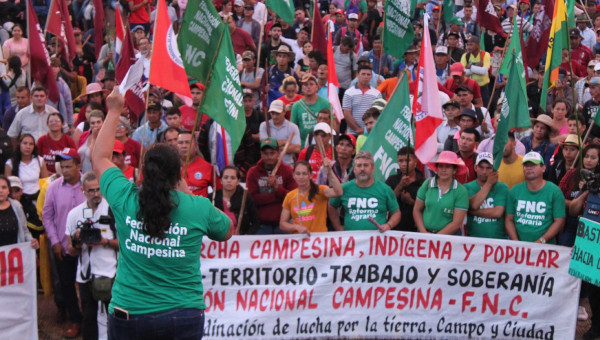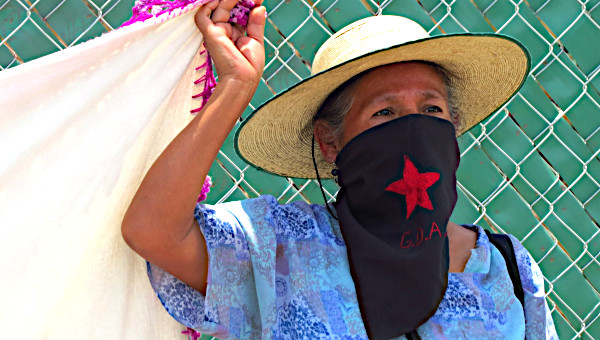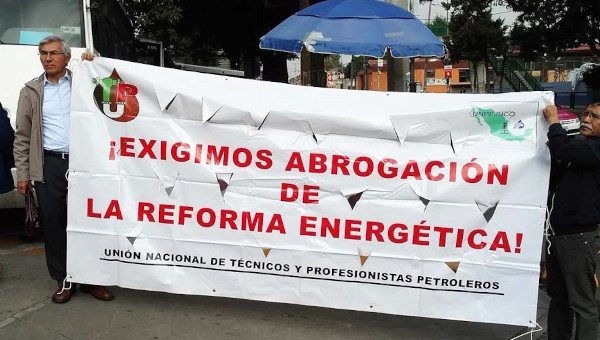Governance, Race, Property, and Profit
“Slavery is associated … with the emergence of several of the most profoundly cherished ideals and beliefs in the Western tradition.” — Orlando Patterson
The subjugation and forced enslavement of Black bodies seized from the continent of Africa had been fundamental to the expansion and growth of the Atlantic domain since the early sixteenth century. In fact, African enslavement had been a mainstay throughout the Spanish Atlantic world for more than a generation prior to English colonization in the Americas. Seeing the Spanish not only as rivals for land, wealth, and resources, the English (not having yet invented their own legalized system of slavery) could also view them as a model concurrent with their French equivalents.1
Thus, by the seventeenth century, the English had to create and/or erect the administrative and legal arrangements necessary to manage and control, what was, for them, a new labour institution of power and governance. This essay will engage with and examine the intricacies and nuances that undergirded the legalized and culturalized formulations of dominance, suppression, and supremacy over African slave labour through the mechanisms of social control woven within European thought: race, law, class, religion, and revolt – immorally and hypocritically counterbalanced by both arbitrary freedoms for the few and strict coercion for the multitudes, alluded to by the Orlando Patterson quote above.
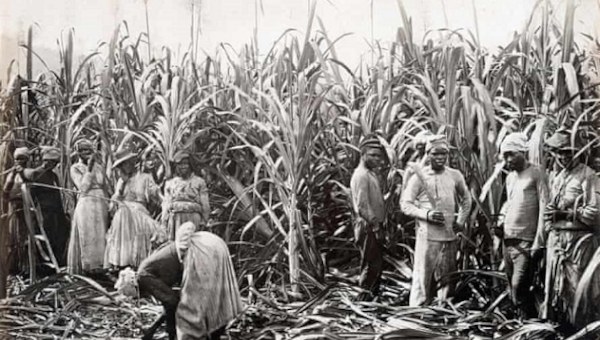
Racialized Slavery in the Atlantic World
Barbados, as esteemed Yale history professor Edward Rugemer asserts, was the codified starting point for racialized slavery in the Atlantic world. The development of racializing enslavement originated hither, but it remained incomplete. As early as 1636, the Barbados Council “excluded Europeans from the group who could be bound for life,” but, as Rugemer specifies, “…they did not yet assume that all Africans or Indians who arrived would be slaves.”2
However, the ancient Aristotelian concept of “the natural slave”3 was certainly well-known by British upper classes of the day as being anyone compelled into “forced labour for life” vs. what was then a novel British formulation of “contracted indentured servitude.” In July 1636, Barbados’s Governor Henry Hawley and his Council initiated perpetual slavery by proclaiming that “Negroes and Indians, that came here to be sold, should serve for life…”4 Hence, Black Africans and indigenous peoples were formally and authoritatively deemed “natural slaves.”
Consequently, at this initial juncture in the island’s socioeconomic development, and thenceforth, “Barbadians [clearly] made distinctions between those who served for life and those who worked under a contract.”5 Sir Hilary Beckles (well-known Barbadian historian) underscores the fact that “sugar production” combined with the legally sanctioned concept of “unfree labour,” were, in reality, the two sinister and compelling forces behind Barbadian planters’ avarice and wealth accumulation.6 In fact, the succeeding generations of Englishmen in Barbados favored themselves with certain freedoms per property and ownership that would embrace a racialized African enslavement, and a system of coercive order and violence that suited their rapacious needs.7
As demonstrated below, history never runs in a straight-line. If we take a closer look at reputable historical texts such as (seventeenth-century English author) Richard Ligon’s A True & Exact History of the Island of Barbados (first published in 1657), we find innate elements that capture the imagination and move against a traditional narrative. From Ligon’s on-the-ground perspective, having lived on the island of Barbados (from 1647 to 1650), he believed that temporary European contracted servitude was treated worse than Negro slaves who happened to be in subjugation for life. Ligon held that “servants were treated worse than the slaves.” As a matter of fact, he delineated their poor nourishment and insufficient lodging (in detail) and outlined the viciousness of their overseers who would, as he stated, “beat a Servant with a cane about the head ’til the blood ran freely.”8 In contrast to Ligon’s assessment, one cannot help but be stunned by the wanton intimidation and legalized measures of violence enacted within “An Act for the Better Ordering and Governing of Negroes” (Barbados 1661), included in the larger work of Acts Passed in the Island of Barbados (from 1643 to 1762), published in 1764 and edited by Richard Hall Esq., Representative in the General Assembly for the Parish of St. Michael’s Barbados. These texts reveal the gruesome and dreadful particulars of the then African slave’s everyday lived experience.

The Acts mentioned provide the horrid and graphic details that challenge Ligon’s assertion stated above. Race and religion are key elements woven throughout the law that not only defined Africans as “heathenish and brutish,” but also clearly delineated all white Europeans (owners and servants alike) as “Christians,” which endowed them with certain divinely indorsed legal privileges – unmistakably demarcating skin-color as the dividing line of natural God-given rights, freedoms, and protections.9 For example, in Clause II of the Barbados Act of 1661, the elite white “men of letters” who authored the proclamation openly delineated the punishments, and threats, thereof, legally sanctioned upon Negro men (and women alike) if they were to enact “violence to any Christian [including white servants] by striking or the like.” Said slave shall be “severely whipped,” his or her “nose shall be slit,” and finally, he or she shall be “burned in the face.” Beyond that, they described Africans as “an uncertain dangerous pride of people … to whom we may extend the legislative power [of punishment given us by Law] for the benefit and good of this plantation.”10 As they concluded, “property rights” and “ownership privileges” imbued within English law, originating from the Magna Carta of 1215, authorized an Elite justification of such malicious violence toward Africans specifically. And, as Rugemer points out, “Slavery was essential, profitable to those invested in it, and fundamentally at war with the humanity of the people enslaved.”11
War is by no means an exaggeration. If we look at the progression of legal mechanisms enumerated in Richard Hall’s work, we find an evolution of ownership, coercion, and control largely instituted by, not only the ravenous want of financial reward on behalf of the English governing class of the island, but also an innate fear of Africans as a people and the possibility or threat of their insurrection. For further illustration, Hall affirmed that the first official law implemented proclaiming Africans as not only chattel, but also as non-persons considered objects of ownership – took place as early as 1668, in “An Act declaring the Negro-slaves of this Island, to be Real Estates,” to be displaced, utilized, traded, and controlled under a strict system of rule.12 This stringent system of control, and the governing class fear it stimulated, led to an even more severe lock-down in “An Act for the encouragement of all Negroes and Slaves that shall discover any Conspiracy,” passed in 1692. Used as an overt force of intimidation, this Act was implemented to discourage, supplant, or suppress any notion of insurrection on behalf of all Africans; and, to stamp-out any and all risks of “Rebellion, Massacre, Assassination, and Destruction.”13
Those that write the rules control the game. Even prior to 1691, the white ruling class eminently dreaded the possibility of rebellion by African slaves thus harshly treated and controlled throughout the island. In fact, by1661, they had already doubled down on their intimidation tactics, woven within legislative dictates, by instituting Martial law (that being, the replacement of civilian government by military rule). As revealed in Clause 17 of the Barbados Act of 1661, which distinctly stated, “if any Negro shall make Insurrection or rise in rebellion … proceed by Martial Law against the Actors … and punish [them] by death or other pain as their Crimes shall deserve.”14
Furthermore, the legislators specified within the law not only the punishments to be meted out, for the above stated crime of insurrection, but also the benefits to be had. Specifically, a sanctioning by law which they had introduced per the loss of their property (said slaves) to be incurred by the public as a whole, “It is further enacted and ordained that the loss of Negroes so executed shall be borne by the public.”15 They (the owner class) provided themselves with remuneratory safeguards and protections (outlined in Clause 18) – an indemnification backed by a self-serving tax strategy, which fell heavily upon the lower-class tenants of the island: “when the present Treasury is not sufficient to satisfy the loss (of said property), a public Levy [is] to be presently made upon the Inhabitants for reparation of the same.”16 This clearly demonstrated the power, influence, freedoms, and duties possessed by a minority of English elite, propelled by a structure of primitive accumulation.
Coercion and Law as Divisive Weapons of War
In response to the lingering possibility of a slave revolt on the island of Barbados, in 1676, the Assembly added draconian amendments to the 1661 “Act for the Better ordering and Governing of Negroes.” In said amendments, racialized difference and abhorrent essentialist qualities were openly demarcated as a tool of division and control that clearly placed the Negro slave at the bottom of the so called “civilized social order” – even in the eyes of poor indentured whites. The Assembly’s reasoning was justified within the preamble to the 1676 amendments, which noted that the 1661 act “hath not sufficiently proved to restrain them [African slaves] from those wicked and barbarous actions their natures are inclined to … [such as] thefts and insolencies.”17 Hence, as Susan Dwyer Amussen confirms, any form of larceny or assault committed by a slave was proclaimed a capital offense as outlined in the original Act. Beyond that, any enslaved individual “who remained a fugitive for more than a year” stood to be summarily executed when apprehended.18 In a tactical move by the governing class, the coercive purpose behind the law was to increase the threat of punishments for slaves’ wrongdoings in the hope that deterring minor offenses would thwart greater ones such as mutiny or revolt.19 Island authorities and Planters relied on a similar blend of terror and coercion to force the increasing slave population into brutal compliance. Again, as alluded to by the Orlando Patterson quote at the outset of this essay, Western values authorized violence within the law that necessitated the brutal relationship between masters and slaves.
Sugar, when it came to the possession and enslavement of Black bodies, was a complex and fundamental ingredient within the development of a system of perpetual slavery essential to the economic progress of the island of Barbados and beyond. A small number of planters commenced experimenting with sugar as early as the1640s, and, at the same time, London brokers who were already ensconced in transatlantic trade founded a commercial slave venture (The Royal African Company) to the island of Barbados straight from Africa. The numbers below prove that English capital accumulation stood at the heart of the ruthless capture and enslavement of Black Africans, “By 1643 there were 6,400 Africans on the island, about one-fourth of a population of at least 25,000, and by 1650 the European population had grown to about 30,000 while the number of Africans had increased to 12,800.”20 Estimates reveal that sugar, by the 1660s, had elevated the population of the island of Barbados to a majority black slave society – which is reflective, as discussed above, within a series of punitive Acts adjudicated on the island throughout the seventeenth century and the palpable numerical fears Africans instilled.
Figure 121
Figure 222
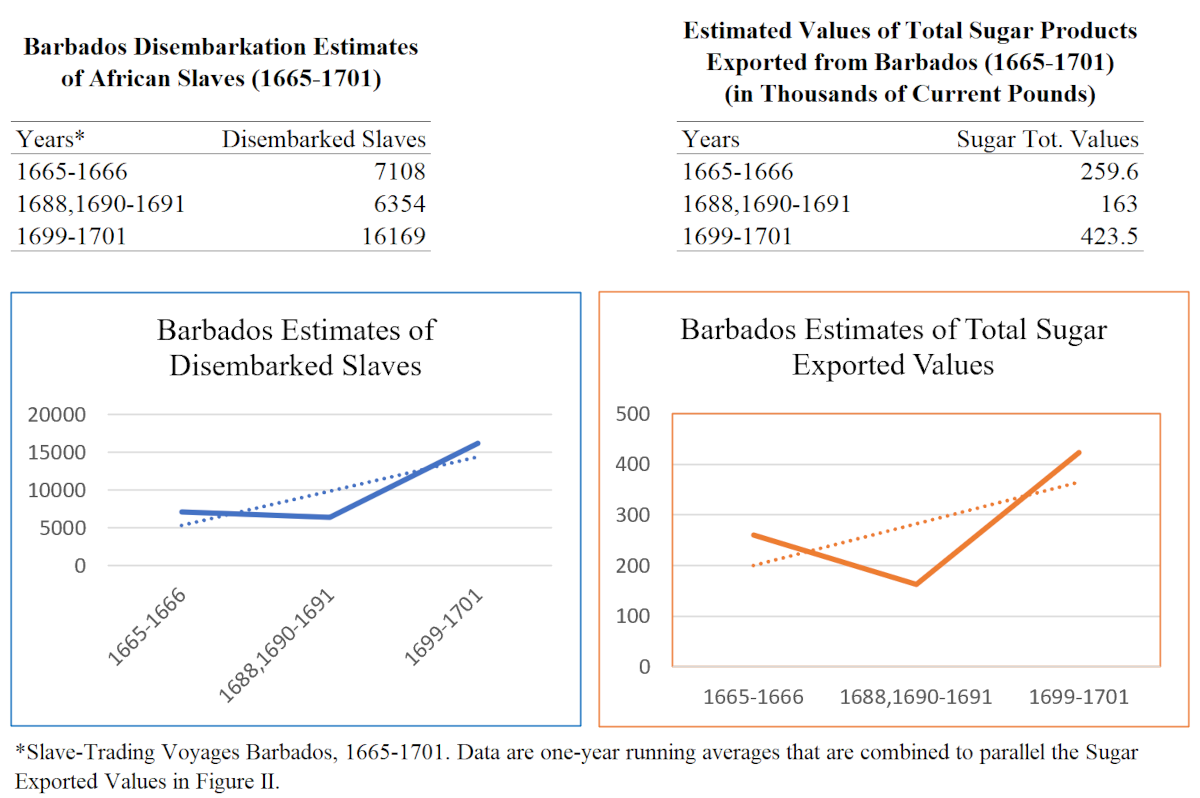
The data above, extracted from The Trans-Atlantic Slave Trade Database, corroborate a direct association between the increased importation of forced African slave labour and the export of the island’s most profitable crop, as made evident by David Eltis’s “New Estimates of Exports from Barbados…, 1665-1701.” The figures show a 154% increase of disembarked Africans from 1688 to 1701, which directly corresponds to a 166% upsurge in the estimated values of total sugar products exported from Barbados in the same period.
From early on, the menace of punishment, coercion, and revolt were always present on the island of Barbados, but as Jennifer Morgan outlines, with the development of sugar manufacture and the increase in the African population, things got worse.23 Stemming from Oliver Cromwell’s re-conquest of Ireland in 1641, thousands of Irish were sent to Barbados as political prisoners and servants to labor alongside African slaves. The harsh treatments condoned within the Acts mentioned earlier in this essay, underpinned by the severity of early sugar production, led to a forceful pushback “against violent overseers,” from both Black and white servitude alike.24 French voyager Beauchamp Plantagenet, visiting the island in 1648, observed a world, where he described, “rich men, [as] having sugar mils” and many hundreds Rebell Negro slaves [absconded] in the woods.”25 Based on the stringent laws passed by an assembly of rich men, as early as 1652, Ligon reported, large numbers of indentured white servants conspired to “cut the throats of their masters,” and ran away to “make themselves not only ‘freemen,’ but Masters of the Island”, and many of the servants involved in that conspiracy were swiftly executed. Ligon continued, with a more sympathetic tone of validation, stating that, “the root cause [of insurrection] grew from their sufferings” and the inability of some “to endure such slavery.”26 As a result, “several Irish servants and negroes [were] out in rebellion.” Indentured servants, as Hilary Beckles affirms, like their African counterparts, were “treated as chattel”, and both groups steadfastly struggled against those conditions.27
Barbados was the birthplace of the concept of race in a class-gripped Atlantic World. Ultimately, as a response to the dangers invoked by all amalgamation of labour both Black and white, assemblies and their strategically “racialized edicts of division,” beginning in seventeenth century Barbados, spread throughout the Caribbean and beyond, including the early formed North American colonies, later planted firmly in South Carolina. In fact, by 1664, the newly established governor of the island of Jamaica, Sir Thomas Modyford (an acolyte of Oliver Cromwell himself), together with other “land hungry” Barbadian elite, passed scarcely modified forms of both the Servant Act and the Slave Act of Barbados, maintaining a race-based “declaration of war” on what they defined as “outlying Spanish Negroes.”28 As Rugemer makes clear, Modyford, as “an agent for the newly formed … Royal African Company in 1663,” motivated by self-interest and profit, “brought with him to the new colony [of Jamaica] an intimate understanding of the effort to establish racial slavery.”29 As an example, by the time of Jamaica’s Servant Act of 1681,30 the assembly introduced, codified, and adopted a somewhat new word, white, in place of the longtime signifier of “Christian” – a change that elucidates the sustained efforts by the elite English of the Caribbean to clearly racialize, demarcate, and justify the enslavement of Black bodies in a class-tiered system of domination.

In conclusion, the rules put in place by the ruling class of Barbados and Jamaica unmistakably delineated their powers over a mass of human beings, in perpetual vassalage, defined as slaves. As argued, the foundations of racialized slavery that developed throughout the latter part of the seventeenth century, in Barbados and Jamaica, mutually and codependently, progressed toward a self-authorized legal system that was grounded in the “protection of property” and the privileges of the planter-elite well into and throughout the eighteenth century.
This essay’s objective was to reveal the fact that constructs of race based on formulations of superiority were sown and birthed in the ruthless Atlantic Slave Trade and its dynamic Sugar Revolution. The elements of law, class, race, religion, and revolt, mentioned within this study, work cumulatively to expose why racialized enslavement occurred and who most benefited from it. In regard to matters of universal rights of humanity, including all creeds and races, when it comes to the relationship between possessors and the possessed, rulers and the ruled, the history of slavery teaches us that, “all human phenomena virtually require that oppression breed resistance, that exploitation be met by fight-back that compels the oppressor to acknowledge the humanity of the oppressed.”31 In the end, fighting fire with fire was the last and only resort left for the enslaved peoples of a darker hue in and throughout the Atlantic World; and, the saga of that struggle endures to this very day. •
Endnotes
- Edward B. Rugemer, “The Development of Mastery and Race in the Comprehensive Slave Codes of the Greater Caribbean during the Seventeenth Century,” The William and Mary Quarterly 70, no. 3 (2013): 432.
- Rugemer, 433.
- Aristotle, Politics, trans. Harris Rackham, Loeb Classical Library (Harvard University Press, 1944), 1254b20.
- William Arnold, Memoirs of the First Settlement of the Island of Barbados, and Other the Carribbee Islands … (near Chancery-Lane, Holborn: E. Owen, 1743), 20.
- Rugemer, “The Development of Mastery,” 433.
- Hilary McD. Beckles and Andrew Downes, “The Economics of Transition to the Black Labor System in Barbados, 1630-1680,” The Journal of Interdisciplinary History 18, no. 2 (1987): 225–47.
- Rugemer, “The Development of Mastery,” 433–34.
- Richard Ligon, A True and Exact History of the Island of Barbados, ed. Karen Ordahl Kupperman (Indianapolis: Hackett, 2011), 94.
- Stanley L. Engerman, Robert L. Paquette, and Seymour Drescher, eds., “An Act for the Better Ordering and Governing of Negroes” Barbados 1661, in Slavery (Oxford University Press, 2001), 105-106.
- Engerman, Paquette, and Drescher, 105.
- Edward B. Rugemer, Slave Law and the Politics of Resistance in the Early Atlantic World (Cambridge, Mass: Harvard University Press, 2018), 2.
- Richard Hall, ed., “An Act Declaring the Negro-Slave of This Island, to Be Real Estates” Barbados 1668, in Acts, Passed in the Island of Barbados. From 1643, to 1762 (London: printed for Richard Hall, 1764), 64–65.
- Richard Hall, ed., “An Act for the Encouragement of All Negroes and Slaves That Shall Discover Any Conspiracy” Barbados 1692, in Acts, Passed in the Island of Barbados. From 1643, to 1762 (London: printed for Richard Hall, 1764), 129.
- Engerman, Paquette, and Drescher, “Barbados Act of 1661” 110–11.
- Engerman, Paquette, and Drescher, 111.
- Engerman, Paquette, and Drescher, 111.
- Quoted in, Susan Dwyer Amussen, “Right English Government: Law and Liberty, Service and Slavery,” in Caribbean Exchanges: Slavery and the Transformation of English Society, 1640-1700 (Chapel Hill: The University of North Carolina Press, 2007), 135.
- Susan Dwyer Amussen, 136.
- Amussen, 135.
- Rugemer, “The Development of Mastery,” 434.
- “The Trans-Atlantic Slave Trade Database (Voyages Data Set),” “Estimates” spreadsheet, 2023.
- David Eltis, “New Estimates of Exports from Barbados and Jamaica, 1665-1701,” The William and Mary Quarterly 52, no. 4 (1995): 631–48.
- Jennifer L. Morgan, Laboring Women: Reproduction and Gender in New World Slavery (Philadelphia: University of Pennsylvania Press, 2004), 44.
- [Acts and Statutes] of the Island of Barbados Made and Enacted since the Reducement of the Same, unto the Authority of the Common-Wealth of England / and Set Forth the Seventh Day of September, in the Year of Our Lord God 1652 … (London: Printed by Will. Bentley, 1654), 17, 28,81.
- Beauchamp Plantaganet, A Description of the Province of New Albion: Preface (London: James Moxon, 1650), 3.
- Ligon, A True and Exact History, 45–46.
- Hilary McD. Beckles, “A ‘Riotous and Unruly Lot’: Irish Indentured Servants and Freemen in the English West Indies, 1644-1713,” The William and Mary Quarterly 47, no. 4 (1990): 515–16.
- Barry Gaspar, “With a Rod of Iron: Barbados Slave Laws as a Model for Jamaica, South Carolina, and Antigua, 1661-1697,” in Crossing Boundaries: Comparative History of Black People in Diaspora, ed. Darlene Clark Hine and Jaqueline McLeod (Bloomington: Indiana Univ. Press, 1999), 353.
- Rugemer, “The Development of Mastery,” 443.
- “An Act of Regulating Servants (1681),” in Acts of Assembly Passed in the Island of Jamaica; from 1681, to 1737, Inclusive (London: Printed by J. Baskett, 1738), 2–5.
- Christopher Tomlins, “Enslaving: Facies Hippocratica,” in Freedom Bound: Law, Labor, and Civic Identity in Colonizing English America, 1580–1865 (Cambridge University Press, 2010), 507.



